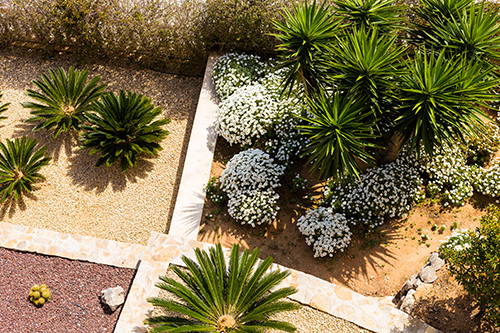Grass lawns demand a lot of time, attention, and water. On the other hand, xeriscaping is a low-maintenance way to create beautiful natural spaces that will flourish in arid climates. Here’s how you can xeriscape your space to create an attractive lawn that requires less upkeep.
The Basics of Xeriscaping
The term xeriscape refers to landscaping that requires very little water. It is comprised of naturally drought-resistant species of plants that can survive and flourish in regions that get little rainfall. Xeriscaping is also popular in communities that have strict water conservation regulations that make regular irrigation difficult or impossible. Because it supports exotic plant life from Australia, the Middle East, and South Africa, xeriscaping is an attractive option for homeowners who want unique landscapes that require few resources and little upkeep.
Creating your own xeriscape space isn’t that difficult. However, it’s important to adopt the following strategies to make sure your plants will survive and thrive.
Try to Use Local Plants
Xeriscapers tend to have the most success when they use plants and grasses which are native to their areas. If you aren’t sure which types of plant or grass to choose for your climate, talk to the folks at your local garden center. Using plants and grasses that are native to your region will greatly improve the natural resistance of your xeriscape. Bermuda grass and buffalo grass are usually nice drought-resistant options that naturally reseed themselves. If you’re starting from scratch, you will likely need to remove some of your existing grass first.
Use Plenty of Mulch
In addition to being aesthetically pleasing, mulch helps prevent erosion and weed growth. It also controls soil temperatures and reduces water loss due to evaporation. Rocks and gravel are nice mulching options in drier climates because they provide good drainage, which allows water to easily reach underlying soil and plant roots.
Make a Plan
The best xeriscaping strategies incorporate diverse plants with varying requirements. Before you plant anything, take a good look at your lawn at different points of the day to see which areas get the most shade and sunlight. You should then separate your yard into oasis, arid, and transition zones. You will add your thirstiest vegetation to your oasis zone and your most drought-resistant plants to your arid zone. The transition zone should combine a drier environment with the lush vegetation in your oasis zone.
Select the Right Plants
Shrubs, succulents, prairie grasses, and small-leafed plants are all popular choices among xeriscapers. That said, your choices will depend on your climate and region. By creating your three planting zones, you will be able to manage your watering more effectively. Bear in mind that while drought-resistant plants flourish in arid climates, they won’t survive in rainy regions.
Irrigate Intelligently
Even drought-resistant vegetation needs a steady supply of water. Xeriscapers have the most success with drip irrigation systems, which use low-pressure delivery methods that ensure better water retention by pushing water deep into the soil near the roots of plants. While it will take an initial investment, drip irrigation is extremely efficient and will save you money over time.









